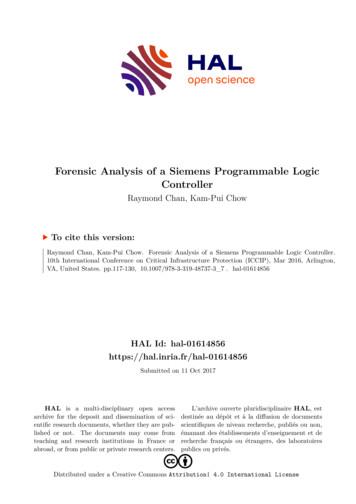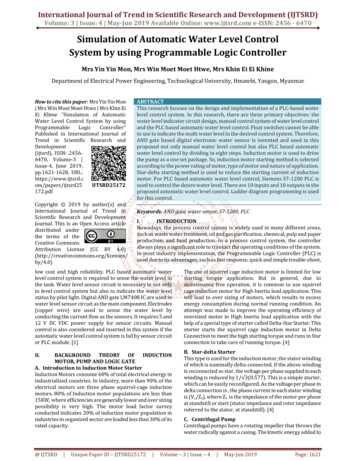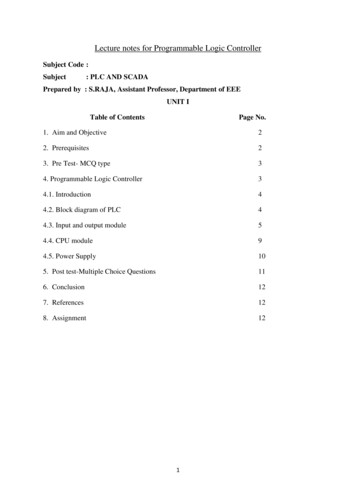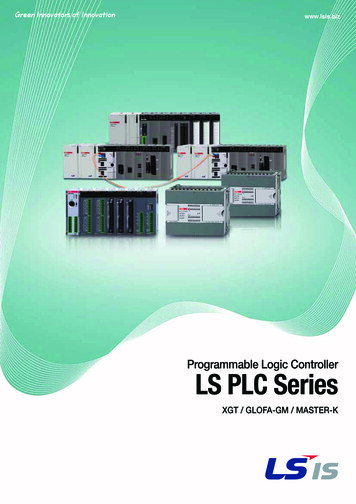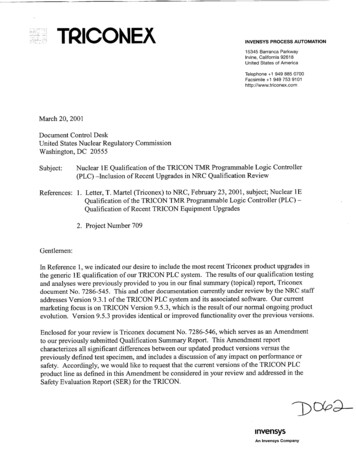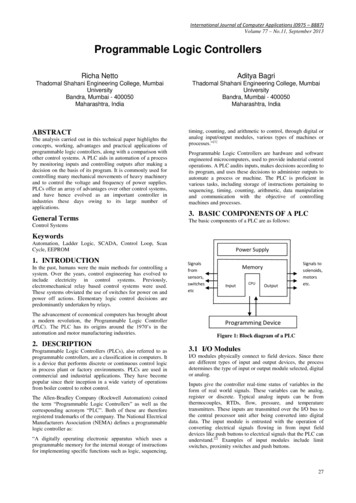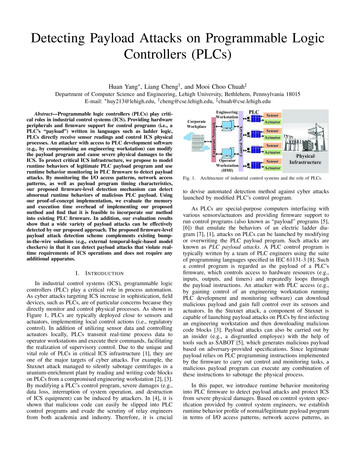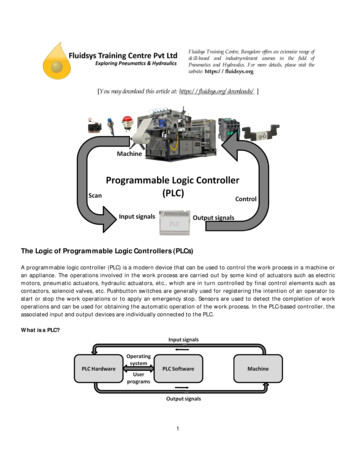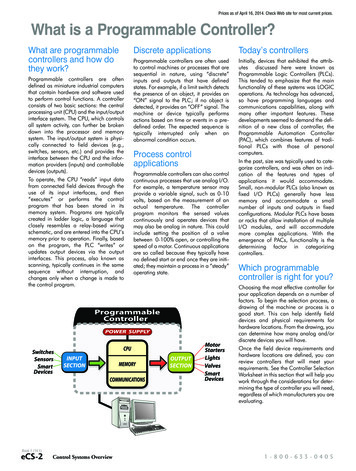
Transcription
What is a Programmable Controller?Prices as of April 16, 2014. Check Web site for most current prices.What are programmablecontrollers and how dothey work?Programmable controllers are oftendefined as miniature industrial computersthat contain hardware and software usedto perform control functions. A controllerconsists of two basic sections: the centralprocessing unit (CPU) and the input/outputinterface system. The CPU, which controlsall system activity, can further be brokendown into the processor and memorysystem. The input/output system is physically connected to field devices (e.g.,switches, sensors, etc.) and provides theinterface between the CPU and the information providers (inputs) and controllabledevices (outputs).To operate, the CPU “reads” input datafrom connected field devices through theuse of its input interfaces, and then“executes” or performs the controlprogram that has been stored in itsmemory system. Programs are typicallycreated in ladder logic, a language thatclosely resembles a relay-based wiringschematic, and are entered into the CPU’smemory prior to operation. Finally, basedon the program, the PLC “writes” orupdates output devices via the outputinterfaces. This process, also known asscanning, typically continues in the samesequence without interruption, andchanges only when a change is made tothe control program.Discrete applicationsProgrammable controllers are often usedto control machines or processes that aresequential in nature, using “discrete”inputs and outputs that have definedstates. For example, if a limit switch detectsthe presence of an object, it provides an“ON” signal to the PLC; if no object isdetected, it provides an “OFF” signal. Themachine or device typically performsactions based on time or events in a predefined order. The expected sequence istypically interrupted only when anabnormal condition occurs.Process controlapplicationsProgrammable controllers can also controlcontinuous processes that use analog I/O.For example, a temperature sensor mayprovide a variable signal, such as 0-10volts, based on the measurement of anactual temperature. The controllerprogram monitors the sensed valuescontinuously and operates devices thatmay also be analog in nature. This couldinclude setting the position of a valvebetween 0-100% open, or controlling thespeed of a motor. Continuous applicationsare so called because they typically haveno defined start or end once they are initiated; they maintain a process in a “steady”operating state.Today’s controllersInitially, devices that exhibited the attributes discussed here were known asProgrammable Logic Controllers (PLCs).This tended to emphasize that the mainfunctionality of these systems was LOGICoperations. As technology has advanced,so have programming languages andcommunications capabilities, along withmany other important features. Thesedevelopments seemed to demand the definition of a new class of controller, theProgrammable Automation Controller(PAC), which combines features of traditional PLCs with those of personalcomputers.In the past, size was typically used to categorize controllers, and was often an indication of the features and types ofapplications it would accommodate.Small, non-modular PLCs (also known asfixed I/O PLCs) generally have lessmemory and accommodate a smallnumber of inputs and outputs in fixedconfigurations. Modular PLCs have basesor racks that allow installation of multipleI/O modules, and will accommodatemore complex applications. With theemergence of PACs, functionality is thedetermining factor in categorizingcontrollers.Which programmablecontroller is right for you?Choosing the most effective controller foryour application depends on a number offactors. To begin the selection process, adrawing of the machine or process is agood start. This can help identify fielddevices and physical requirements forhardware locations. From the drawing, youcan determine how many analog and/ordiscrete devices you will have.Once the field device requirements andhardware locations are defined, you canreview controllers that will meet yourrequirements. See the Controller SelectionWorksheet in this section that will help youwork through the considerations for determining the type of controller you will need,regardless of which manufacturers you areevaluating.Book 1 (14.1)eCS-2Control Systems Overview1 - 80 0 - 633 - 0405
PLC vs. PAC vs. PC-based ControlPrices as of April 16, 2014. Check Web site for most current prices.The most common control systems todayare the Programmable Logic Controller(PLC), PC-based control, and the mostrecent addition, the ProgrammableAutomation Controller (PAC). While theyeach share a few attributes with the others, their differences lie mainly in formfactor and functionality. Data exchange with businessapplications (spreadsheets,ERP systems) One or more third-party PC cards, suchas those for motion control or visionsystems Communication with serial ornetworked field devices Storage or access to large amounts ofdata Large number of PID loops (64 or more) Open architecture for C/C orVisualBasic systems Online productivity tools to analyze andimprove performance of the processProgrammable Logic ControllerThe Farlex Dictionary defines a PLCas follows: “A programmable microprocessor-based device that is used indiscrete manufacturing to control assembly lines and machinery on the shop flooras well as many other types of mechanical, electrical and electronic equipmentin a plant. Typically RISC based andprogrammed in a specific-purposeprogramming language, a PLC isdesigned for realtime use in rugged,industrial environments. Connected tosensors and actuators, PLCs arecategorized by the number and type ofI/O ports they provide and by their I/Oscan rate.”PLCs excel at sequential logic and basicanalog control. Their modularity andruggedness make them suitable for awide variety of automation applications.PC-based ControlWith Personal Computer technologybooming in the 1980s and 1990s, therewas a natural progression to considerusing the processing power in these unitsto solve more complicated applicationsthat extended well beyond the realm ofdigital and analog I/O manipulation.These more advanced capabilites couldbe performed far more efficiently byhardware and software native to thecommercialpersonalcomputer.Examples of these requirements include:CompanyInformationThis hybrid arose not only to solvecomplex applications with the speed andprocessing power of a PC-based system,but to do it on a platform capable ofwithstanding the environmental poundingthat PLCs have been subjected to formany years.Ideally, a PAC encompasses the followingfeatures:PLC Feel Modular footprint Industrial reliability Wide array of I/O modulesand system configurationsPC Power Large memory andfast processing High-level data handlingand enterprise connectivity Extensive communicationscapability, multiple protocols andfield networksPACs are most often used foradvanced machine control, processcontrol, data acquisition and equipmentmonitoring.In a PC-based control system, a standard operating system such as WindowsNT supports HMI and control softwarerunning on a PC platform, either areadily available commerical model oran industrially hardened unit. PC architecture allows the system to seamlesslysupport a variety of third-party I/O,specialty motion and vision systems, andfield networks.Programmable Automation ControllerA programmable automation controller isa compact controller that combines thefeatures and capabilities of a PC-basedcontrol system with that of a typical programmable logic controller (PLC).Although each PAC vendor uses theirown development environment (IDE) andprogramming language, PAC networkingis typically based on IP and Ethernet.This class of controller provides more memory capacity and processing power whichallows for better data processing capabilities, and connectivity to enterprise businesssystems from the plant floor.Additionally, PACs offer the benefit ofeasy integration formulti-domainsystems comprising Human MachineInterface (HMI), discrete control andprocess control. The need for a Human MachineInterface (HMI) as well as control Advanced data manipulation andadvanced math functionsBook 1 (14.1)w w w. a u to m a t i o n d i re c t . c o mControl Systems OvervieweCS-3Control SystemsOverviewCLICK PLCDo-MorePLCs OverviewDo-More H2PLCDo-More T1HPLCDirectLOGICPLCs tyControllerOverviewProductivity3000UniversalField I/OSoftwareC-MoreHMIC-More MicroHMIViewMarqIndustrialMarqueesOther HMICommunicationsAppendixBook 1Terms andConditions
Considerations for Choosing a ControllerPrices as of April 16, 2014. Check Web site for most current prices.Use the worksheet on the following pages as a checklist of the things to consider when determiningprogrammable controller requirements. It lists the most important areas to consider when choosinga system, and provides space for recording determinations of your system needs.ConsiderationInformation to Record1.Proposed System New system2.EnvironmentalIssues3.Discrete DevicesCodes/environmentalissues to considerTotal inputs:ACDCTotal inputs:4.Analog DevicesVoltageCurrentExistingsystemNo codes orenvironmentalissues to considerTotal outputs:ThermoHigh speed counterPositioningServo/stepperBASIC programmingReal-time clockOthers (list)Determine whether your system is new or existing: Will your systembe installed from scratch or are there existing products alreadyinstalled? The rest of your system will need to be compatible withnew components.Why this is im portant : Certain controller products may not becompatible with others. Making sure your existing products arecompatible with any new products you are researching will saveyou time and money. Check appropriate entry.Consider any environmental issues that will affect your application(temperature, dust, vibration, codes specific to your facility, etc.).Why this is important: Certain environments may affect the operation of a controller. For example, typical controllers have an operating temperature of 0-55 degrees Celsius (32-130 degrees F). Ifyour application will include any extreme environmental conditions, or you have specific codes at your facility that must be met,you will need to either research products that meet those specifications or design the installation to meet requirements. Checkappropriate entry.Determine how many discrete devices your system will have. Whichtypes (AC, DC, etc.) are needed?Total outputs: Why this is important: The number and type of devices your systemwill include is directly linked to the amount of I/O that will beACnecessary for your system. You will need to choose a controllerDCthat supports your I/O count requirements and has modules thatsupport your signal types.Enter quantities and type based on corresponding field devices.RTD5.SpecialtyModules orFeatures(applicationspecific)Why this is importantVoltageCurrentDetermine how many analog devices your system will have.Which types (voltage, current, temperature, etc.) are needed?Why this is important: The number and type of devices your systemwill include is directly linked to the amount of I/O that will benecessary for your system. You will need to choose a controller thatsupports your I/O count requirements and has modules thatsupport your signal types. Enter quantities and type based on corresponding field devices.Determine whether your system will require any specialty features:Will your application require high-speed counting or positioning?What about a real-time clock or other specialty feature?Why this is important: Specialty functions are not necessarily available in a controller CPU or in standard I/O modules.Understanding the special functions your system may perform willhelp you determine whether or not you will need to purchase additional specialty modules. Check all features required.Table continued on the following pageBook 1 (14.1)eCS-4Control Systems Overview1 - 80 0 - 633 - 0405
Considerations for Choosing a ControllerPrices as of April 16, 2014. Check Web site for most current prices.ConsiderationInformation to RecordHardware requirements:K program memory required(estimated)K data memory required(estimated)Fast scan time required?6.CPU RequiredBattery backup required?Software/special functionrequirements:PIDWhy this is importantDetermine the type of CPU you will need: How much memory will yoursystem require? How many devices will your system have (determines datamemory)? How large is your program, and what types of instructions will yourprogram include (determines program memory)? How fast a scan time doyou need?Why this is important: Data memory refers to the amount of memory neededfor dynamic data manipulation and storage in the system. For example,counter and timer instructions typically use data memory to store setpoints,current values, and other internal flags. If the application requires historicaldata retention, such as measured device values over a long period of time,the size of the data tables required may determine the CPU model youchoose. Program memory is the amount of memory needed to store thesequence of program instructions that have been selected to perform theapplication. Each type of instruction requires a specific amount of programmemory, typically defined in a programming manual. Applications that arebasically sequential in nature can rely on the I/O device rule of thumb to estimate program memory (five words of memory for each I/O device); complexapplications will be more difficult to judge.If scan time is important in your application, consider the CPU processorspeed as well as instruction execution speed. Some CPUs are faster atboolean logic but slower with data handling instructions.If special functions such as PID are required, the CPU you select may makethose functions easier to perform.For program memory required, follow this rule of thumb: 5 words of proOthers (see Programming section below) gram memory for each discrete device and 25 words for each analogdevice. Check or calculate all requirements that apply.Floating Point Math7.I/O LocationsRemote LocationsLocal . . .onlySpecific remote I/O protocolrequired? Which one?EthernetPLC to PLC8.CommuicationsModbus RTUASCII (interface to serial devices)OtherPID loopsFloatingnumber of loops neededpoint math9.ProgrammingDrumsequencerSubroutinesDirect interruptsOthers (list)Determine where your I/O will be located: Will your system require onlylocal I/O, or both local and remote I/O locations?Why this is important: If subsystems will be needed at long distances fromthe CPU, you will need a controller that supports remote I/O. You will alsohave to determine if the remote distances and speeds supported will beadequate for your application. Serial and Ethernet-based I/O hardwareare two typical choices available for most systems. This I/O may also bereferred to as distributed I/O, and may require a particular protocol, suchas Modbus.Enter number of physical locations needed, and if/what specific protocolmay be required.Determine your communication requirements: Will your systembe communicating to other networks, systems or field devices?Why this is important: Communication ports (other than the programmingport) are not always included with a controller. Knowing your systemcommunication requirements will help you choose a CPU that supportsyour communication requirements, or additional communication modulesif necessary. Check any/all communications functions required.Determine your programming requirements: Does your application requireonly traditional programming instructions, or are special instructions necessary?Why this is important: Certain controllers may not support every type of instruction. You will need to choose a model that supports all instructions that youmay need for a specific application. For example, built-in PID functions aremuch easier to use than writing your own code to perform closed-loopprocess control. Typical instructions such as timers, counters, etc. are availablein most controllers; note any other special instructions required here. Checkany/all programming functions required.Book 1 (14.1)w w w. a u to m a t i o n d i re c t . c o mControl Systems OvervieweCS-5CompanyInformationControl SystemsOverviewCLICK PLCDo-MorePLCs OverviewDo-More H2PLCDo-More T1HPLCDirectLOGICPLCs tyControllerOverviewProductivity3000UniversalField I/OSoftwareC-MoreHMIC-More MicroHMIViewMarqIndustrialMarqueesOther HMICommunicationsAppendixBook 1Terms andConditions
rSummaryPrices as of April 16, 2014. Check Web site for most current prices.Those making the buying decisions for Programmable Controllerapplications can have very different needs. We offer a selection of controller families that can fit a variety of applications.Regardless if you are a newcomer to programmable controllers or ifyou are a seasoned veteran; whether you need simple discrete controlor if you need to calculate complex algorithms lightning fast, we havea controller family that is perfect for you.CLICK: Our best value PLCThe CLICK PLC is becoming one ofthe industry’s favorite control systems in the142 I/O or less category.Easy for new userBasicmachine controlLowest costStandard CPUs: 8 DC In / 6 DC Out (sinking)8 DC In / 6 DC Out (sourcing)8 DC In / 6 Relay Out8 AC In / 6 Relay Out8 DC In / 6 DC Out (sinking)8 DC In / 6 DC Out (sourcing)8 DC In / 6 Relay Out8 AC In / 6 Relay OutAnalog CPUs:Simple analog 4 DC In / 4 DC Out (sinking),2 Analog In, 2 Analog Out(current/voltage selectable) 4 DC In / 4 DC Out (sourcing),2 Analog In, 2 Analog Out(current/voltage selectable)FREE SoftwareFast CPUBasic CPUs: 4 DC In / 4 Relay Out,2 Analog In, 2 Analog Out(current/voltage selectable) Built-in communication ports (two in BasicCPUs, three in Standard and Analog CPUs) Optional battery backup(Standard and Analog CPUs only) Real time clock/calendar(Standard and Analog CPUs only) Removable terminal blocks for easy wiring Stackable discrete and analog I/O optionmodules (DIN-rail or panel mountable) Program AND documentation stored in CPU Decimal memory addressing 21 easy-to-use instructions 8,000 steps of program memoryDo-more H2 and T1H Series CPUs: Spend Less, Do More!CPUw/ built-in EthernetDo-more is a micro-modular PLC that leverages the I/O tocreate an incredibly powerful PLC at a fraction of the cost ofcomparable controllers.H2 works with mostDL205 I/O modules.T1H works with mostTerminator I/O. Cost effective hardware Documentation can be stored onboard Built-in communications includeUSB programming, serial, and(optional) Ethernet Practical counting/pulse Ethernet-connected expansion I/O High-performance processorsAdvanced discreteProcess controlExpandabilityFREE SoftwareDirectLOGIC: Long-running PLCs FREE programming software(with built-in simulator) Powerful control over programexecution Enhanced troubleshooting tools FREE online training with coupon Starter kits availableSix PLC platforms to choose from in the DirectLOGIC family:Advanced discreteDirectLOGIC PLCs (nano fixed I/O to modular units) are industryworkhorses, time-tested in some of the toughest industrial settings.Basicprocess controlAll platforms use the same DirectSOFT programming software, soyour investment is protected.ExpandabilityEthernet DL05 stand-alone brick PLC with one option slot (30 I/O max) DL06 stand-alone brick PLC with 4 option slots (100 I/O max) DL105 stand-alone brick PLC with high amp relays (18 I/O max) DL205 powerful modular PLC with the most available option modules(up to 16,384 I/O max) DL305 time tested, legacy control platform (up to 368 I/O max) DL405 time tested, legacy control platform (up to 16,384 I/O max)FREE Software**100-word program limitation, 395 for unlimited program sizesProductivity3000: Premium features at a value priceAdvanced discreteand processThe Productivity3000 controller shatters the price per feature paradigm in everycategory, with prices that can’t be beat and a two-year warranty on all modules.Data collectionExtensivecommunicationDistributed I/OFREE Software Latest additionsinclude high-speedinput and outputmodules, and alower-cost CPU andremote I/O slavemodule Auto discovery of hardware, including remoteI/O bases and GS drives when connected to theEthernet remote I/O network Tag name database programming Task management Advanced “fill-in-the-blank” instructions Seamless corporate database connectivity Run-time editing and project transfer Project file, tag database and ladderdocumentation stored in the CPU FREE Productivity Suite softwareBook 1 (14.1)eCS-6Control Systems Overview1 - 80 0 - 633 - 0405
Application BriefsDL06 PLC puts heaters tothe testPyromatics Automation Systems of CrystalLake, Il. was contracted by a customer todevelop a Life Cycle Test Station for itselectric heating elements.This test station needed a user-friendlygraphical interface to give operators theability to select multiple ramp/soak parameters, output voltages, temperature sensortypes, amperage ratings and total cyclecounts on tests for the cast-in electric heaterplatens. The system also needed to recordtemperature, volts, and current drawthroughout the test for use in quality reports.Also, a failure of the heater required a safeshutdown of the test while alerting the quality department of the alarm condition.Prices as of April 16, 2014. Check Web site for most current prices.CompanyInformationSemi cab sheetingproduction improvedITS, a design build firm in Columbus, Ohiospecializes in industrial automation. Thecompany was contacted by a division ofInternational Harvester responsible for themanufacturing of semi cabs. InternationalHarvester uses automated machines toplace aluminum rivets on sheeting that isattached to the frame of the semi cabs. Theoriginal CNC machines were becomingantiquated and needed to be upgraded.The completed system allows users to quickly connect the heater to be tested, enter testparameters, and run the test. Trend chartson the C-more panel track test parametersand quickly identify potential issues such assudden drops in current or temperature.Alarm reporting and history are also automatically recorded, allowing the operator todetermine causes of failure. Data from thetest can be easily uploaded to a USB thumbdrive from the C-more panel. The data canthen be imported into the user’s choice ofword processor or spreadsheet.Lockhart Power Company owns andoperates a hydroelectric plant located onthe Broad River in upstate South Carolina.CLICK PLCDo-MorePLCs OverviewDo-More H2PLCDo-More T1HPLCDirectLOGICPLCs GICDL205The plant includes an 8-gate dam feedinga canal that channels the water flow to thepowerhouse. The powerhouse containsfive turbine generators with a combinedpower capacity of over 17 MW. The damand turbine control system receives datafrom power, flow, and level sensingdevices to perform monitoring and controlof the dam, generators, and associatedequipment.Pyromatics selected the cost-effectiveDirectLOGIC DL06 PLC as the heart ofthe system because of its ability to control upto eight PID loops and the multiple expansion slots available for thermocouple cardsand analog input modules. It also controlstwo heaters, two chillers and an array ofpanel indicators, buttons, switches andrelays.A C-more 10-inch TFT touch-screen operator interface was used to provide operatorswith the necessary interface to operate andmonitor the tests.Cost-effective I/Osimplifies hydroelectricplant controls upgradeControl SystemsOverviewITS chose a DL205 PLC as the new controller for the machines, along with discreteI/O and an H2-CTRIO high-speed countermodule that drives a dual axis servo. An H2ECOM Ethernet Communications card linksthe machines back to an office for dataacquisition. ITS also added a 15-inch touchscreen for diagnostics.In the new system, an operator stampssheets of aluminum to welded frameworkwith a handful of hand rivets and thenplaces the product onto a dual axis servotable. After the operator selects one of fivedifferent parts programs, the machine willnavigate the panel under the head assembly, which is responsible for the drilling andriveting, with a tolerance of 1/10 of amillimeter. The panel is drilled and a rivet isinstalled and squeezed to approximately1200 PSI, producing a rivet consistencywithin .003 in. After completion of the panel(between 64 and 138 rivet locations), themachine will return to its home position andawait the next product.The solution increased productivity byapproximately 30% and provides an easyway to run and maintain the machines.w w w. a u to m a t i o n d i re c t . c o mLockhart Power contracted North ForkElectric in Crumpler, NC, to lend theirexpertise to a renovation of the conrtolsystem.The system consists of seven DirectLOGICDL205 micro-modular PLCs with built inPID functionality. Each of the five systemsfor generator control includes discrete andanalog I/O, and an Ethernet communications module. The remaining two PLCs areconfigured in a master/slave arrangementand control the dam gates, located upriver from the powerhouse, via radiomodems. Operator interfaces include two6-inch color touch screen panels and aWindows NT-based PC running theLookoutDirect SCADA/HMI softwarepackage.In the automatic mode, the PLC can start,stop, and operate the generator, andcontrol startup and synchronization of theturbine. Changing the generator gateposition varies the flow of water to theturbine.The dam control system controls the eightcanal gates located at the dam, whichregulate the flow of water downstream tothe turbines.Control Systems OverviewBook 1 eld I/OSoftwareC-MoreHMIC-More MicroHMIViewMarqIndustrialMarqueesOther HMICommunicationsAppendixBook 1Terms andConditions
Programmable Controller Selection GuidePrices as of April 16, 2014. Check Web site for most current prices. Standard CPU8 In/6 Out142142 4 In/4 Out 2 In/2 Out140140 H2-DM125665,536 H2-DM1E25665,536 T1H-DM125665,536 T1H-DM1E25665,536 P3-550 CPU3520 59,840 P3-530 CPU3520 Analog CPU3520Built-In Remote I/O142AnalogIn & Out142AC, DC,Relay I/O8 In/6 OutSeries / CPUBasic CPU1 Scan time is based on type and amount of ladder logic instructions andtotal system I/O2 Scan times may vary during Run-Time Transfers 6 6 3 DeviceNet & ProfiBus Slave modules for the DL205 series are installed in place ofthe CPU in the CPU slot4 High Speed inputs available on DC input models / Pulse output available onDC output models5 RS-485 for Modbus protocol only6 The Ethernet ports on the H2-DM1E and T1H-DM1E allow expansion beyond thelocal base.Book 1 (14.1)eCS-8Modbus TCP Ethernet ProtocolBuilt-In RS-485 Multi-drop portBuilt-In RS-422 Multi-drop portBuilt-In RS-232 Serial portBuilt-In Local I/O Expansion PortsBuilt-In Ethernet & USBHigh-speed I/O modules withMotion Control16 PID loops, Complex Math formulas &/or Array ManipulationCPU CommunicationsDigital I/O & SimpleLogic RequirementsAnalog I/O, Simple Mathand data manipulationProcess High-SpeedControl and MotionTotal Possible I/OBuilt-In I/OStage Programming(State Machine Control)BasicMachineControlI/O CapacityLocal I/O(with Expansion)ProductivityDo-moreCLICK PLCController FamilySelection CriteriaControl Systems Overview1 - 80 0 - 633 - 0405
Programmable Controller Selection GuidePrices as of April 16, 2014. Check Web site for most current prices.CompanyInformationControl SystemsOverviewCLICK PLC Freeform Expressions in MathBuilt-in High Speed Counter& Pulse OutputRun-Time Transfer(Scan updates during transfer)Run Mode Edits(Outputs pause during transfer) Email Instruction Drum Sequencer DirectLOGICDL305Floating point Math Stage Programming 8kstepsDo-More H2PLCDo-More T1HPLCBattery Backed MemoryClock / CalendarTotal MemoryDeviceNet/Profibus SlavesEthernet or Serial Remote I/OBasic CoprocessorSerial RS-232 & RS-485ASCII INASCII OutDirectNet MasterDirectNet SlaveK-Sequence Slave Do-MorePLCs OverviewProgrammabilitySub-Divided Program Tasks Modbus RTU MasterModbus RTU SlavePorts & ProtocolsEthernet (10/100 Mb)Communications andSpecialty Modues 262kb 262kb 262kb 262kb 50Mb 2 25Mb 2 DirectLOGICPLCs viewProductivity3000UniversalField I/OSoftwareC-MoreHMIC-More MicroHMIViewMarqIndustrialMarqueesOther HMICommunicationsAppendixBook 1Terms andConditionsBook 1 (14.1)w w w. a u to m a t i o n d i re c t . c o mControl Systems OvervieweCS-9
Programmable Controller Selection GuidePrices as of April 16, 2014. Check Web site for most current prices.All CPUs20 In/16 Out100100 All CPUs10 In/8 Outn/a18 D2-230256256D2-240256896D2-250-1768 16,384*D2-2601280 16,384* 4-4406402688D4-4502048 16,384*AnalogIn & OutAC, DC,Relay I/O* 16384 (fully expanded H4-EBC slave bases, using V-memory & bit of wordinstructions)1 Scan time is based on type and amount of ladder logic instructions andtotal system I/O2 Scan times may vary during Run-Time Transfers Modbus TCP Ethernet Protocol Built-In RS-485 Multi-drop port Built-In RS-422 Multi-drop port Built-In RS-232 Serial port Built-In Remote I/O Built-In Local I/O Expansion Ports30Built-In Ethernet & USBAnalog I/O, limited PID, SimpleMath and data manipulation30High-speed I/O modules withM
A programmable automation controller is a compact controller that combines the features and capabilities of a PC-based control system with that of a typical pro - grammable logic controller (PLC). This hybrid arose not only to solve complex applications with the speed and processing power of a PC-based system, but to do it on a platform capable of

